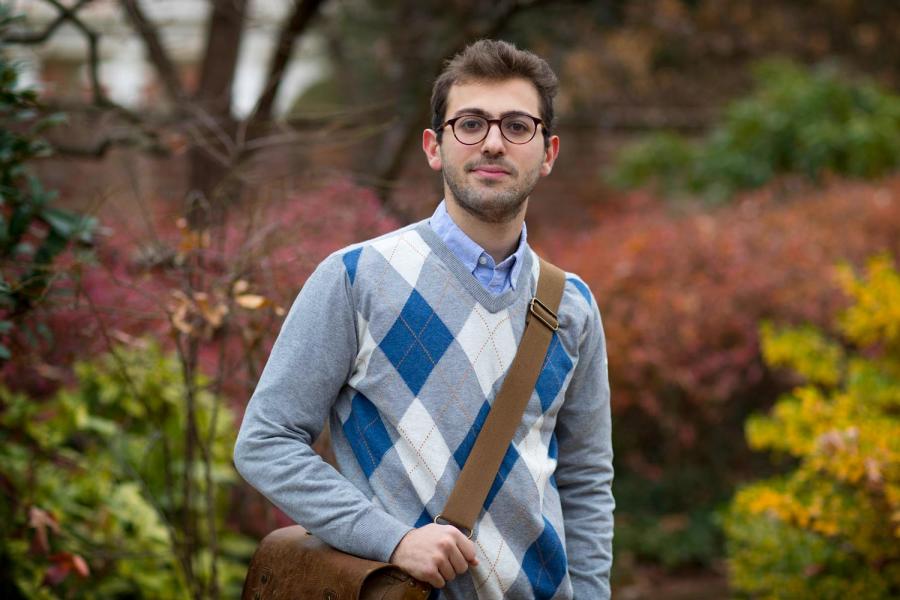Standing outside surveying the destruction around him, Ozbulut’s cell phone began to ring. It was his son, Osman Ozbulut, calling from Charlottesville.
“We spoke for only a couple of minutes, but I was relieved to hear that he and my other family members were safe,” Osman Ozbulut said. His mother had been visiting his sisters in Turkey’s capital, Ankara, far outside the destruction zone.
Ozbulut then texted Asfaw, who at this point was deeply engaged in testing the device. “I told him that he may not have heard, but there was an earthquake in my hometown. And I told him, ‘Let’s make a contribution to the engineering community with this test.’”
A short while later, Asfaw texted back the early results of the testing. The device was performing better than expected.
“To be honest, I was having mixed emotions in that moment,” Ozbulut said. “But it was nice to see that the test went very well and that this system, which isn’t very expensive to develop, could be incorporated into future buildings to make them more resilient.”
Preventing Damage Before It Happens
There is a lot of activity going on under our feet every day as the continents we live on drift over the Earth’s mantle. About every minute somewhere in the world, they stick, building up pressure until the rock cracks, causing an earthquake. On average, roughly 1,400 earthquakes happen every day, and about 275 of them are strong enough to be felt.
Sometimes they are so significant they cause widespread destruction. There is also no way to predict when they will come or how extreme they might be. A case in point: In 2010, earthquakes killed as many as 320,000 people globally, while last year they claimed only 288 lives.
Studies show that 75% of deaths in earthquakes can be attributed to poorly built structures that collapse. In many cases, the buildings weren’t constructed according to codes that usually consider seismic activity.
With new technologies, Ozbulut said, communities could have the capability to do more than just prevent buildings from collapsing in earthquakes.
“Buildings constructed with current seismic design codes are expected to protect occupants and avoid collapse, but it is expected that the structures will suffer significant damage. Basically, the building will take the punch, but will allow us to get out alive,” Ozbulut said. “With the damage and losses communities have been experiencing following natural hazard events, there is a push toward moving beyond the current design paradigm and addressing continued functionality after a hazard event.”
This is the driving reason why Asfaw and Ozbulut have been focused on using shape memory alloys in the development of a system to keep buildings habitable after earthquakes. Their device is designed to be easily installed onto the existing support structures of buildings so that earthquake energy is dissipated.
“The current seismic design philosophy is about creating buildings that don’t collapse, but that may take severe structural damage or be deformed and leaning. This requires either demolishing the buildings or replacing huge sections of building components, which can be costly,” Ozbulut said. “In the case of our device, the shape metal alloy will not only diminish damage, it will self-center the structure, allowing the building to be occupied immediately after an earthquake.”
Promising Results
The night before the earthquake in Turkey, and before his big testing day, Asfaw hadn’t been able to sleep. A year of research, computer simulations and fabrication were leading up to the first test of the damper system he and Ozbulut designed and fabricated. He was anxious about how the testing would go.
Early the next morning, Asfaw transported the UVA blue- and orange-painted damper to the lab at the Virginia Transportation Research Council, which is located on Grounds a short way from Ozbulut’s and Asfaw’s offices at UVA Engineering. The lab is the only place nearby that has a large-scale tension and compression testing machine of the strength needed to most accurately test a device of that size.
Gritting his teeth, Asfaw used a monkey wrench to tighten a couple of the shape memory alloy cables attached to the steel plates, before hoisting the heavy device with a forklift and placing it into the jaws of the testing apparatus. He then set up lasers to measure how well the shape memory alloy cables absorbed the pressure as the testing apparatus put the damper through a rigorous deformation.










